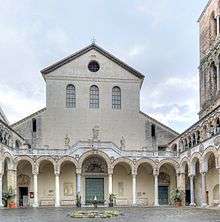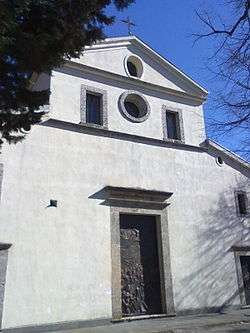Roman Catholic Archdiocese of Salerno-Campagna-Acerno
| Archdiocese of Salerno-Campagna-Acerno Archidioecesis Salernitana-Campaniensis-Acernensis | |
|---|---|
 Salerno Cathedral | |
| Location | |
| Country | Italy |
| Ecclesiastical province | Salerno-Campagna-Acerno |
| Statistics | |
| Area | 1,398 km2 (540 sq mi) |
| Population - Total - Catholics |
(as of 2010) 552,000 540,000 (97.8%) |
| Parishes | 163 |
| Information | |
| Denomination | Catholic Church |
| Rite | Roman Rite |
| Established | 6th century |
| Cathedral | Cattedrale-Basilica di S. Matteo (Salerno) |
| Co-cathedral |
Concattedrale-Basilica di S. Maria della Pace (Campagna) Concattedrale di S. Donato (Acerno) |
| Current leadership | |
| Pope | Francis |
| Archbishop | Luigi Moretti |
| Emeritus Bishops | Gerardo Pierro |
| Website | |
| www.diocesisalerno.it | |
The Archdiocese of Salerno-Campagna-Acerno (Latin: Archidioecesis Salernitana-Campaniensis-Acernensis) is a Roman Catholic ecclesiastical territory in Campania, southern Italy, created in 1986. The historic Archdiocese of Salerno was in existence from the tenth century, having been elevated from a sixth-century diocese. The Diocese of Acerno was combined with the archdiocese in 1818.[1][2]
On Thursday, June 10, 2010, Pope Benedict XVI appointed Archbishop Luigi Moretti, until then the vice-gerent of the Vicariate of Rome, as Archbishop, succeeding Archbishop Gerardo Pierro.
History
Gaudentius was bishop in 499. Other bishops were: Asterius, who went to Constantinople with Pope Agapitus in 534; St Gaudiosus (eighth century); Petrus (834), formerly Bishop of Canusio, who took refuge at Salerno when the Saracens destroyed his capital, and built the Church of San Giovanni Battista; Bernardus (850), who restored several buildings.
In the eighth century the city of Salerno was in the power of the Lombard dukes of Benevento. In 984 Salerno became an archiepiscopal see, the first archbishop being Amato. Other archbishops were:
- San Alfano (1058–85), who received the exiled Pope Gregory VII
- Romualdo I (1121)
- Romualdo II Guarna (1153)
- Nicolo Agello (1181)
- Caesarius of Alagno (1225–63)
- Guglielmo de' Godoni (1298), chancellor of the Duke of Calabria, whose successors, to Orso Minutolo (1330), resided at Avignon
- Barnaba Orsini (1441), who restored the cathedral
- Pietro Guglielmo Rocca (d. 1482)
- Giovanni Vera (1500), later a cardinal, who was sent on several pontifical legations to France and to England
- Girolamo Seripando (1554), theologian and former general of the Augustinians, whose doctrines on justification, akin to those of Luther, were rejected at the Council of Trent, and who afterwards became a cardinal
- Gaspar Cervantes de Gaeta (1564), who founded the seminary
- Marc Antonio Colonna (1568), who established another college for clerics
- his nephew, Marc Antonio Colonna (1574), the author
- Mario Bolognini (1591), who distinguished himself in France in the controversies with the Huguenots;
- Giovanni de Torres (1658), who reformed the lives of the clergy;
- Gregorio Caraffa (1664), a Theatine and reformer;
- Antonio Salomone, who, after the annexation of the kingdom of Naples, was imprisoned without reason (1886), and at the beginning of the war with Austria was sent into exile.
From 1818 Salerno had for suffragans the diocese of Capaccio e Vallo, diocese of Policastro, diocese of Potenza e Marsico Nuovo, and diocese of Nusco.
The See of Acerno, which appears a diocese since 1136, is united with it; among its bishops was the Franciscan Antonio Bonito (1493).\
Ordinaries
Diocese of Salerno
Latin Name: Salernitana
Erected: 6th Century
Archdiocese of Salerno
Latin Name: Salernitana
Elevated: 10th Century
- Romualdo Guarna (1121 Appointed – 21 Jan 1136 Died)
- ...
- Bertrand de La Tour, O.F.M. (3 Sep 1320 Appointed – 30 Apr 1321 Resigned)
- Arnaud Royardi, O.F.M. (30 Apr 1321 Appointed – 27 Jun 1330 Appointed, Archbishop (Personal Title) of Sarlat)
- ...
- Bertrand de Castronovo (de Chateauneuf) (7 Jan 1349 Appointed – 8 Jan 1364 Appointed, Archbishop of Embrun)
- ...
- Nicola Piscicelli (21 Apr 1449 Appointed – Apr 1471 Died)
- Pietro Guglielmo de Rocha (30 Aug 1471 Appointed – 18 Oct 1482 Died)
- Giovanni d'Aragona (13 Jan 1483 Appointed – 17 Oct 1485 Died)
- Juan de Vera (10 Jul 1500 Appointed – 4 May 1507 Died)
- Federico Fregóso (5 May 1507 Appointed – 1529 Resigned)
- Niccolò Ridolfi (7 Feb 1533 Appointed – 19 Dec 1548 Resigned)
- Luis Torres (bishop) (19 Dec 1548 Appointed – 13 Aug 1553 Died)
- Girolamo Seripando, O.E.S.A. (30 Mar 1554 Appointed – 17 Apr 1563 Died)
- Gaspar Cervantes de Gaeta (1 Mar 1564 Appointed – 23 Jul 1568 Appointed, Archbishop of Tarragona)
- Marcantonio Colonna (seniore) (13 Oct 1568 Appointed – 25 Jun 1574 Resigned)
- Marco Antonio Marsilio (25 Jun 1574 Appointed – 24 Apr 1589 Died)
- Mario Bolognini (7 Jan 1591 Appointed – 25 Feb 1605 Died)[3]
- Juan Beltrán Guevara y Figueroa (4 Dec 1606 Appointed – 28 Nov 1611 Appointed, Archbishop (Personal Title) of Badajoz)[4]
- Lucio Sanseverino (19 Nov 1612 Appointed – 25 Dec 1623 Died)
- Gabriel Trejo y Paniagua (9 Jun 1625 Appointed – 12 Feb 1630 Died)
- Giulio Savelli (28 Jan 1630 Appointed – 15 Sep 1642 Resigned)
- Fabrizio Savelli (15 Sep 1642 Appointed – 1 Apr 1658 Resigned)
- Giovanni de Torres (1 Apr 1658 Appointed – Sep 1662 Died)
- Gregorio Carafa (archbishop), C.R. (23 Jun 1664 Confirmed – 22 Feb 1675 Died)
- Alfonso Álvarez Barba Ossorio, O. Carm. (22 Jun 1676 Confirmed – Oct 1688 Died)
- Gerolamo Passarelli (14 Nov 1689 Appointed – Nov 1690 Died)
- Marcos de Ostos, O. de M. (25 Jun 1692 Appointed – 19 Nov 1695 Died)
- Bonaventura Poerio, O.F.M. Obs. (11 Nov 1697 Appointed – 18 Nov 1722 Died)
- Pablo Vilana Perlas (12 May 1723 Confirmed – 6 May 1729 Died)
- Giovanni Fabrizio de Capua (11 Dec 1730 Confirmed – 1 Mar 1738 Died)
- Casimiro Rossi (5 May 1738 Appointed – 27 Dec 1758 Died)
- Isidoro Sánchez de Luna, O.S.B. (28 May 1759 Confirmed – 13 May 1783 Resigned)
- Giulio (Giovanni Michele) Pignatelli, O.S.B. (25 Jun 1784 Confirmed – 17 Aug 1796 Died)
- Salvatore Spinelli, O.S.B. (18 Dec 1797 Confirmed – 8 Jan 1805 Died)
- Fortunado Pinto (26 Jun 1805 Confirmed – 20 Nov 1825 Died)
Archdiocese of Salerno (-Acerno)
Latin Name: Salernitana (-Acernensis)
United: 27 June 1818 with the Diocese of Acerno
- Camillo Alleva (19 Dec 1825 Confirmed – 30 Oct 1829 Died)
- Michelangelo Lupoli (30 Sep 1831 Confirmed – 28 Jul 1834 Died)
- Marino Paglia (6 Apr 1835 Confirmed – 5 Sep 1857 Died)
- Antonio Salomone (21 Dec 1857 Confirmed – 9 Mar 1872 Died)
- Domenico Guadalupi (6 May 1872 Appointed – 8 Mar 1877 Resigned)
- Valerio Laspro (20 Mar 1877 Appointed – 22 Sep 1914 Died)
- Carlo Gregorio Maria Grasso, O.S.B. (7 Apr 1915 Appointed – 30 Mar 1929 Died)
- Nicola Monterisi (5 Oct 1929 Appointed – 30 Mar 1944 Died)
- Demetrio Moscato (22 Jan 1945 Appointed – 22 Oct 1968 Died)
- Gaetano Pollio, P.I.M.E. (5 Feb 1969 Appointed – 20 Oct 1984 Resigned)
- Guerino Grimaldi (20 Oct 1984 Succeeded – 12 Apr 1992 Died)
Archdiocese of Salerno-Campagna-Acerno
Latin Name: Salernitana-Campaniensis-Acernensis
United: 30 September 1986 with the Diocese of Campagna
- Gerardo Pierro (25 May 1992 Appointed – 10 Jun 2010 Retired)
- Luigi Moretti (10 Jun 2010 Appointed – )
See also
References
- Cappelletti, Le Chiese d'Italia, XX (Venice, 1857);
Notes
- ↑ "Archdiocese of Salerno-Campagna-Acerno" Catholic-Hierarchy.org. David M. Cheney. Retrieved February 29, 2016
- ↑ "Metropolitan Archdiocese of Salerno–Campagna–Acerno" GCatholic.org. Gabriel Chow. Retrieved February 29, 2016
- ↑ "Archbishop Mario Bolognini" Catholic-Hierarchy.org. David M. Cheney. Retrieved March 21, 2016
- ↑ "Archbishop Juan Beltrán Guevara y Figueroa" Catholic-Hierarchy.org. David M. Cheney. Retrieved February 29, 2016
External links
![]()
